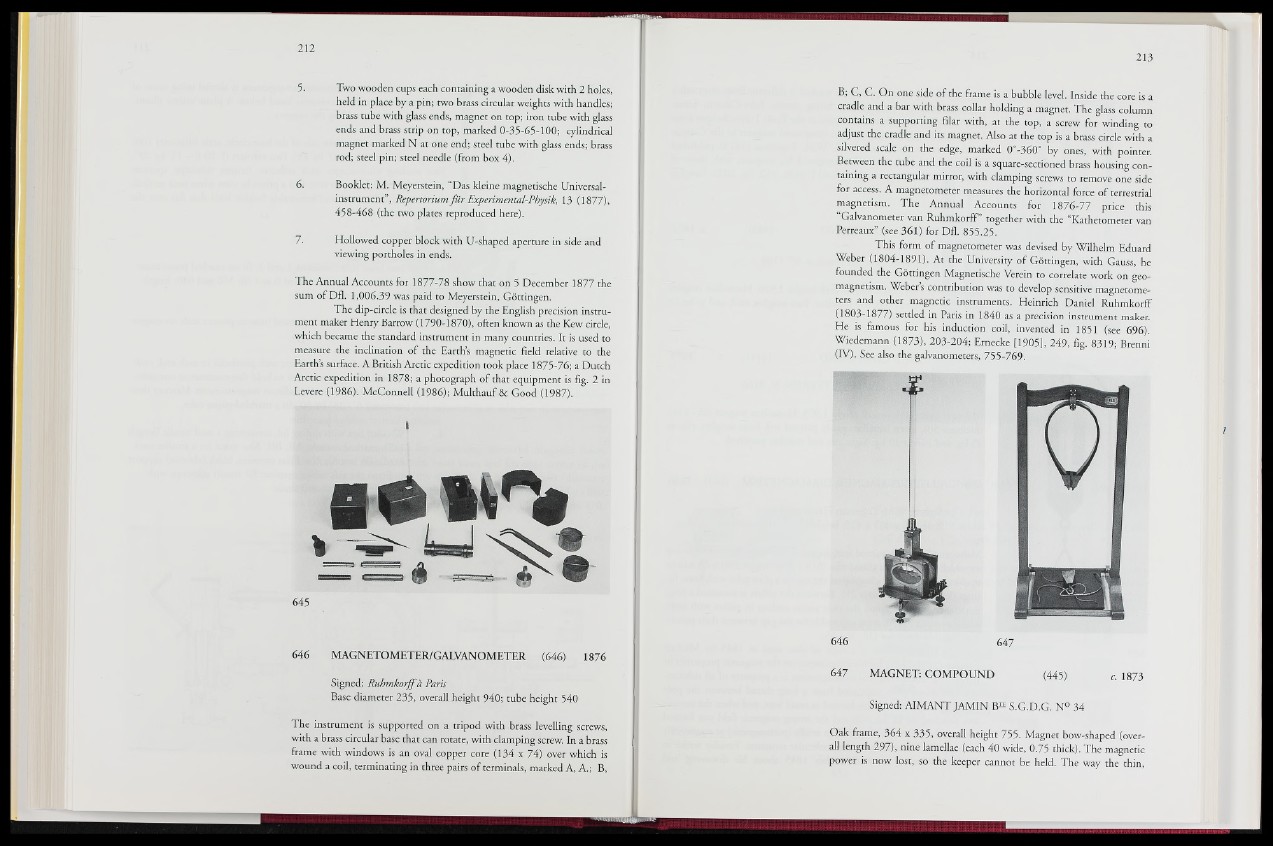
5- Two wooden cups each containing a wooden disk with 2 holes,
held in place by a pin; two brass circular weights with handles;
brass tube with glass ends, magnet on top; iron tube with glass
ends and brass strip on top, marked 0-35-65-100; cylindrical
magnet marked N at one end; steel tube with glass ends; brass
rod; steel pin; steel needle (from box 4).
6. Booklet: M. Meyerstein, “Das kleine magnetische Universal-
instrument”, Repertorium fu r Experimental-Physik, 13 (1877),
458-468 (the two plates reproduced here).
7. Hollowed copper block with U-shaped aperture in side and
viewing portholes in ends.
The Annual Accounts for 1877-78 show that on 5 December 1877 the
sum of Dfl. 1,006.39 was paid to Meyerstein, Gottingen.
The dip-cirde is that designed by the English precision instrument
maker Henry Barrow (1790-1870), often known as the Kew circle,
which became the standard instrument in many countries. It is used to
measure the inclination of the Earths magnetic field relative to the
Earth’s surface. A British Arctic expedition took place 1875-76; a Dutch
Arctic expedition in 1878; a photograph of that equipment is fig. 2 in
Levere (1986). McConnell (1986); Multhauf & Good (1987).
646 MAGNETOMETER/GALVANOMETER *(646) 1876
Signed: Ruhmkorffh Paris
Base diameter 235, overall height 940; tube height 540
The instrument is supported on a tripod with brass levelling screws,
with a brass circular base that can rotate, with clamping screw. In a brass
frame with windows is an oval copper core (134 x 74) over which is
wound a coil, terminating in three pairs of terminals, marked A, A.; B,
B; C, C. On one side of the frame is a bubble level. Inside the core is a
cradle and a bar with brass collar holding a magnet. The glass column
contains a supporting filar with, at the top, a screw for winding to
adjust the cradle and its magnet. Also at the top is a brass circle with a
silvered scale on the edge, marked 0°-360° by ones, with pointer.
Between the tube and the coil is a square-sectioned brass housing containing
a rectangular mirror, with clamping screws to remove one side
for access. A magnetometer measures the horizontal force of terrestrial
magnetism. The Annual Accounts for 1876-77 price this
Galvanometer van Ruhmkorff together with the “Kathetometer van
Perreaux” (see 361) for Dfl. 855.25.
This form of magnetometer was devised by Wilhelm Eduard
Weber (1804-1891). At the University of Gottingen, with Gauss, he
founded the Gottingen Magnetische Verein to correlate work on geo-
magnetism. Weber s contribution was to develop sensitive magnetometers
and other magnetic instrument^ Heinrich Daniel Ruhmkorff
(1803-1877) setded in Paris in 1840 as a precision instrument maker.
He is famous for his induction coil, invented in 1851 (see 696).
Wiedemann (1873), 203-204; Ernecke [1905], 249, fig. 8319; Brenni
(IV). See also the galvanometers, 755-769.
646 647s
647 MAGNET: COMPOUND (445) c. 1873
Signed: AIMANT JAMIN B“ S.G.D.G. N° 34
Oak frame, 364 x 335, overall height 755. Magnet bow-shaped (overall
length 2 9 ^ nine lamellae (each 40 wide, 0 .» th ick ). The magnetic
power is; now lost, so the keeper cannot be held. The way the thin,